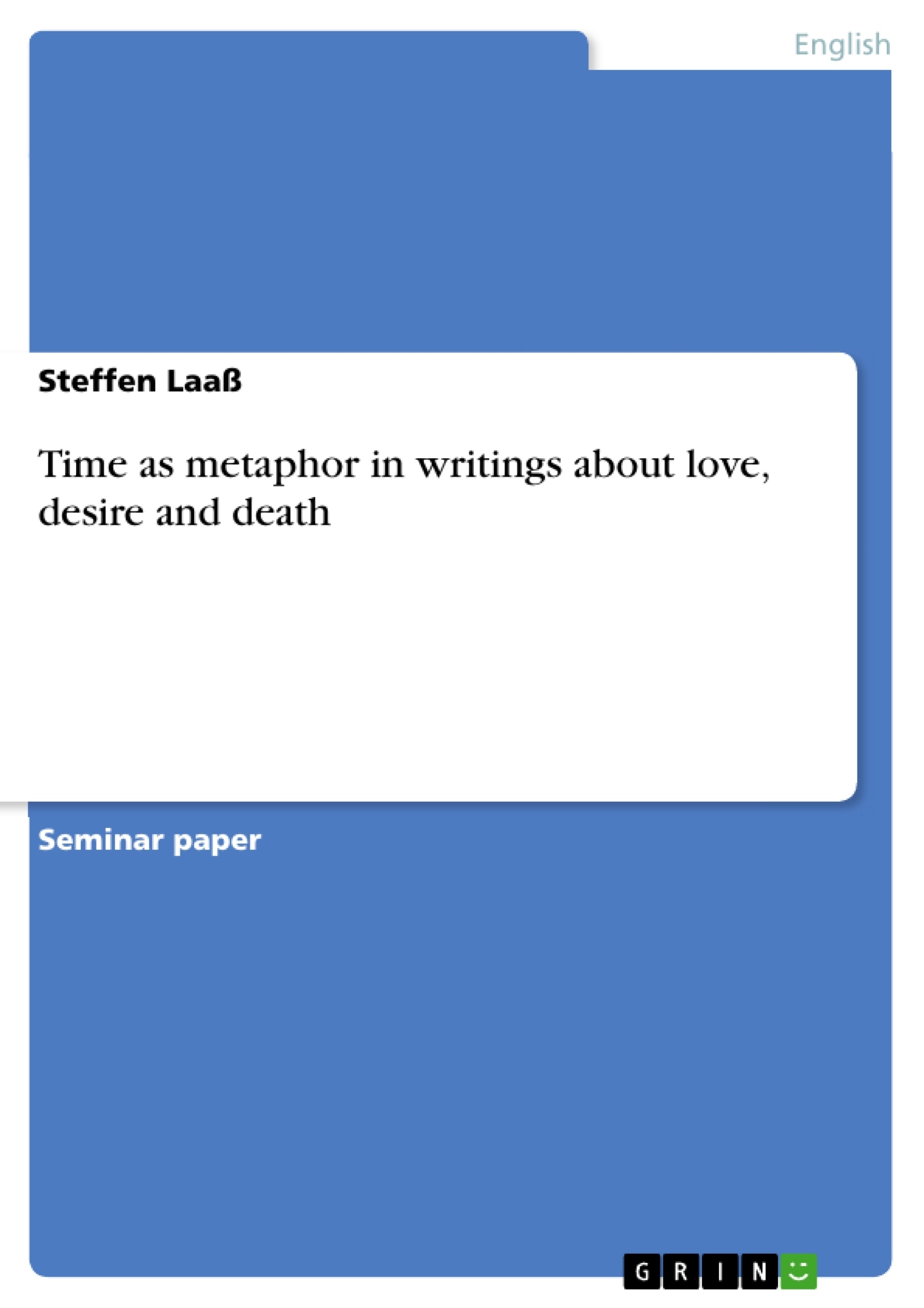1. Introduction
The Renaissance was an exciting age. It was a time of exploration and discovery. People were eager for knowledge and keen on unravelling fundamental mysteries that make up their existence: What is Man? Which position does he take in the universe? What is he there for at all? Why is life so short? What is love?
Without generations being so inquisitive and inquiring, human progress would have come to a standstill. Luckily, people increasingly became aware of the fact that they are an integral part of nature’s changing course and controlled by an external force which is far beyond their power: time.
In this essay, the concept of time is of utmost interest. It shall serve as a microscope to examine literary and theoretical writings that deal with such fundamental issues like love, desire and death. Their readings are presented from a fascinating angle where time functions as a metaphor. To this end, three core texts will be explored: William Shakespeare’s tragedy Romeo and Juliet and his narrative poem The Rape of Lucrece, and Sigmund Freud’s Mourning and Melancholia. Before we embark upon a ‘metaphorical reading’, I present an interesting framework that will come in useful when we investigate the texts. First, we study the relationship between time and metaphor.
2. Metaphorizing time
Let us imagine an elderly long-bearded man dressed in a robe. He is bald, but he has a forelock of hair. With him, he carries a scythe and an hourglass. Sometimes he is depicted cradling a baby in his arms … This mythical figure is commonly known as Father Time.
This example vividly shows how abstract ideas like that of time lose their obscurity and become more apprehensible by means of personification. However ungraspable the notion of time may be, personifying facilitates the determination of time’s typical features on a non-abstract level.
I must note at this point that, in this essay, I will not draw a distinction between the concepts of personification and metaphor because I regard personification as the ultimate metaphor achievable. When we are able to personify something, the abstract becomes us, like us – and it is the notion of ‘likeness’ upon which both personification and metaphor are based.
Table of Contents
- Introduction
- Metaphorizing time
- Turner's classification scheme of time
- The workings of time in Romeo and Juliet
- Time in Lucrece
- Time in Freud's Mourning and Melancholia
- Conclusion
Objectives and Key Themes
This essay explores the concept of time as a metaphor in literary and theoretical writings, examining its relationship to themes such as love, desire, and death. The analysis focuses on three core texts: William Shakespeare's Romeo and Juliet, The Rape of Lucrece, and Sigmund Freud's Mourning and Melancholia.
- Metaphorical representation of time in literature and theory
- The connection between time, love, desire, and death
- Analysis of Shakespeare's Romeo and Juliet, The Rape of Lucrece, and Freud's Mourning and Melancholia
- The role of time in shaping narrative and character development
- The interplay between subjective and objective perceptions of time
Chapter Summaries
- Introduction: Introduces the essay's focus on the concept of time as a metaphor, highlighting the Renaissance era's inquisitive spirit and its exploration of fundamental existential questions. The essay aims to analyze how time functions as a metaphor in literary and theoretical works, with a specific focus on Romeo and Juliet, The Rape of Lucrece, and Mourning and Melancholia.
- Metaphorizing time: This chapter delves into the nature of metaphor and its role in understanding abstract concepts like time. The chapter uses the figure of Father Time as an example of how personification helps to make abstract ideas more concrete and graspable. The chapter also examines how metaphors like "Time flies" reveal the multifaceted nature of time and its impact on human experience.
- Turner's classification scheme of time: This chapter introduces Turner's framework for understanding different aspects of time, which includes objective time, personal experience, agent, realm and sphere, natural time, medium of cause and effect, particular moments or periods, revealer or unfolder, and rhythm. The chapter emphasizes how this framework can serve as a valuable tool for analyzing the concept of time in literary and theoretical works.
- The workings of time in Romeo and Juliet: This chapter analyzes the role of time in Shakespeare's Romeo and Juliet, highlighting how the play's tragedy arises from the interplay of time, love, and fate. It explores how the characters' desires clash with the relentless passage of time, leading to tragic consequences. The chapter also examines how the play's "speedy" nature and its emphasis on unfortunate timing contribute to its overall impact.
Keywords
The primary themes and concepts explored in this essay include metaphor, time, love, desire, death, Shakespeare, Romeo and Juliet, The Rape of Lucrece, Freud, Mourning and Melancholia, and the Renaissance era.
- Quote paper
- Steffen Laaß (Author), 2005, Time as metaphor in writings about love, desire and death, Munich, GRIN Verlag, https://www.grin.com/document/70530



